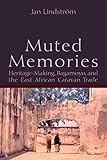Muted Memories : Heritage-Making, Bagamoyo, and the East African Caravan Trade / Jan Lindström.
Material type: TextPublisher: New York ; Oxford : Berghahn Books, [2019]Copyright date: ©2019Description: 1 online resource (398 p.)Content type:
TextPublisher: New York ; Oxford : Berghahn Books, [2019]Copyright date: ©2019Description: 1 online resource (398 p.)Content type: - 9781789201727
- 9781789201734
- 967.823 23
- DT449.B34 L56 2019
- online - DeGruyter
| Item type | Current library | Call number | URL | Status | Notes | Barcode | |
|---|---|---|---|---|---|---|---|
 eBook
eBook
|
Biblioteca "Angelicum" Pont. Univ. S.Tommaso d'Aquino Nuvola online | online - DeGruyter (Browse shelf(Opens below)) | Online access | Not for loan (Accesso limitato) | Accesso per gli utenti autorizzati / Access for authorized users | (dgr)9781789201734 |
Frontmatter -- Contents -- Illustrations -- Maps and Figures -- Preface -- Introduction -- Part I. Heritage-Making, Branding, and Globalization -- 1. Bagamoyo: A History of Practices, Principles, and Partnership in Heritage-Making -- 2. Heritage-Making: The 2002 International Conference -- 3. Fractures in the Image of Bagamoyo: Despair or Joy? -- 4. World Heritage and Globalization: The Bagamoyo Case -- Part II. Commerce, Competition, and Consumerism: Bagamoyo and the Caravan Trade -- 5. Entrepreneurs and Explorers from the Heart of Africa -- 6. Pawned, Preyed Upon, Purchased, or Punished: Slaves and Slavery in Nineteenth-Century East Africa -- 7. Conflicts and Clashes in the Competition over the Caravan Trade on the Central Routes -- 8. Bagamoyo and the Caravan Trade: The Entrance to the Heart of Africa -- 9. Old Bagamoyo -- 10. Fluid Identities: Politics of Identity in Multicultural Bagamoyo -- 11. Conspicuous Competitive Consumption and Communication by Means of Cloth -- 12. Intruders and Terminators: The End of the Story -- Epilogue -- Glossary -- References -- Index
restricted access online access with authorization star
http://purl.org/coar/access_right/c_16ec
In the late nineteenth century, tens of thousands of porters carried ivory every year from the African interior to Bagamoyo, a port town at the Indian Ocean. In the opposite direction, they carried millions of meters of cloth, manufactured in the USA, Europe, and India. This book examines the centrality of the caravan trade, both culturally and economically, to Bagamoyo’s development and cosmopolitan character, while also exploring how this history was silenced when Bagamoyo was instead branded as a slave route town in 2006 in an attempt to qualify it for the UNESCO World Heritage List.
Mode of access: Internet via World Wide Web.
In English.
Description based on online resource; title from PDF title page (publisher's Web site, viewed 25. Jun 2024)


